
Rue de Rivoli is a street in central Paris, France. It is a commercial street whose shops include leading fashionable brands. It bears the name of Napoleon's early victory against the Austrian army, at the Battle of Rivoli, fought on 14–15 January 1797. The Rue de Rivoli is an example of a transitional compromise between an environment of prestigious monuments and aristocratic squares, and the results of modern town-planning by municipal authorities.

Palais Royal–Musée du Louvre is a station on Line 1 and Line 7 of the Paris Métro. Situated in the heart of the 1st arrondissement, it most notably serves the Palais-Royal, Comédie-Française and Louvre.

The Palais-Royal is a former royal palace located in the 1st arrondissement of Paris, France. The screened entrance court faces the Place du Palais-Royal, opposite the Louvre. Originally called the Palais-Cardinal, it was built for Cardinal Richelieu from about 1633 to 1639 by the architect Jacques Lemercier. Richelieu bequeathed it to Louis XIII, and Louis XIV gave it to his younger brother, the Duke of Orléans. As the succeeding dukes of Orléans made such extensive alterations over the years, almost nothing remains of Lemercier's original design.

Louis Tullius Joachim Visconti was an Italian-born French architect and designer.
Paris is characterised by 19th century design and architecture, but has many areas with structures who's design dates back further. These sections are often not referenced on modern-day maps of Paris, crossing current arrondissements. These older quarters are best described and categorised independently of modern administrative boundaries.
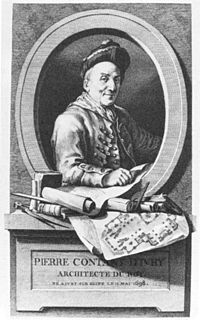
Pierre Contant d'Ivry, was a French architect and designer working in a chaste and sober Rococo style and in the goût grec phase of early Neoclassicism.
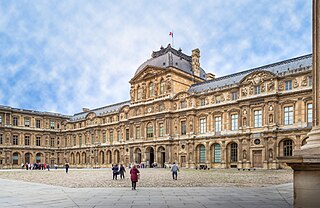
The Louvre Palace, often referred to simply as the Louvre, is an iconic French palace located on the Right Bank of the Seine in Paris, occupying a vast expanse of land between the Tuileries Gardens and the church of Saint-Germain l'Auxerrois. Originally a military facility, it has served numerous government-related functions in the past, including intermittently as a royal residence between the 14th and 18th centuries. It is now mostly used by the Louvre Museum, which first opened there in 1793.

Pierre-Louis Moreau-Desproux was a pioneering French neoclassical architect.

The rue Saint-Honoré is a street in the 1st arrondissement of Paris, France.
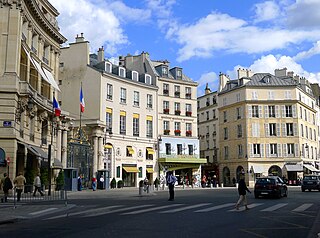
Place Beauvau is a public square in the 8th arrondissement of Paris, at the intersection of the Rue du Faubourg-Saint-Honoré, Avenue de Marigny, Rue des Saussaies and Rue de Miromesnil. It is located in the La Madeleine neighbourhood, next to the Élysée Palace.
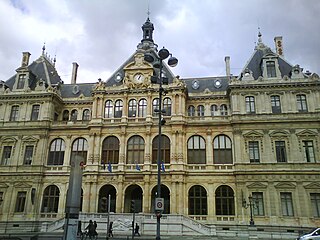
Les Cordeliers is one of the central quarters in the 2nd arrondissement of Lyon, France. It is mainly known for the Place des Cordeliers in its centre. Around the square, there are many notable monuments, including the Église Saint-Bonaventure and the Palais de la Bourse.
The Rue Rambuteau is a street in Paris, France, named after the Count de Rambuteau who started the widening of the road prior to Haussmann's renovation of Paris. The philosopher Henri Lefebvre lived on the street and observed from his window the rhythms of everyday life at the intersection located behind the Centre Georges Pompidou.
Joseph-Henri Deverin (1846-1921) was a French architect and urban planner. He was the chief architect of historic monuments.
This article presents the main landmarks in the city of Paris within administrative limits, divided by its 20 arrondissements. Landmarks located in the suburbs of Paris, outside of its administrative limits, while within the metropolitan area are not included in this article.

The Petit Luxembourg is a French hôtel particulier and the residence of the president of the French Senate. It is located at 17–17 bis, rue de Vaugirard, just west of the Luxembourg Palace, which serves as the seat of the Senate, in the 6th arrondissement of Paris. Originally built around 1550 to the designs of an unknown architect, it is especially noted for the surviving Rococo interiors designed in 1710–1713 by the French architect Germain Boffrand. Further west, at 19 rue de Vaugirard, is the Musée du Luxembourg.
Events from the year 1665 in France.
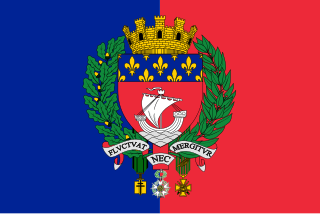
The following outline is provided as an overview of and topical guide to Paris:

Rue Beaujolais is a street in the 1st arrondissement of Paris, France.

Rue de Valois is a street in the Palais-Royal quarter in the 1st arrondissement of Paris, France.














